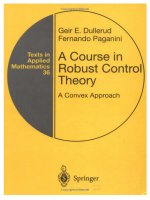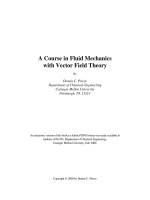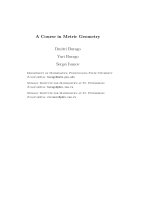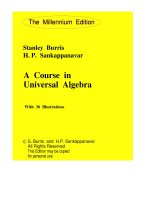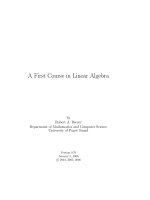A course in ABStract algebra
Bạn đang xem bản rút gọn của tài liệu. Xem và tải ngay bản đầy đủ của tài liệu tại đây (10.44 MB, 516 trang )
NICHOLAS JACKSON
A COURSE IN
ABSTRACT ALGEBRA
D R A F T: JA N UA RY 3 1 , 2 0 1 7
To Abigail and Emilie
We may always depend upon it that
algebra which cannot be translated
into good English and sound common
sense is bad algebra.
— William Kingdon Clifford
(1845–1879),
The Common Sense of the Exact Sciences
(1886) 21
Preface
Mathematics is written for mathematicians
— Nicolaus Copernicus (1473–1543),
preface to De Revolutionibus Orbium
Cœlestium (1543)
Contents
1
2
3
4
5
Preface
v
Groups
1
1.1 Numbers
1
1.2 Matrices
17
1.3 Symmetries
20
1.4 Permutations
24
Subgroups
39
2.1 Groups within groups
39
2.2 Cosets and Lagrange’s Theorem
49
2.3 Euler’s Theorem and Fermat’s Little Theorem
62
Normal subgroups
69
3.1 Cosets and conjugacy classes
69
3.2 Quotient groups
80
3.A Simple groups
91
Homomorphisms
103
4.1 Structure-preserving maps
103
4.2 Kernels and images
110
4.3 The Isomorphism Theorems
116
Presentations
133
5.1 Free groups
134
5.2 Generators and relations
144
5.3 Finitely generated abelian groups
165
5.A Coset enumeration
178
5.B Transversals
186
5.C Triangles, braids and reflections
197
viii
6
7
8
9
a course in abstract algebra
Actions
205
6.1 Symmetries and transformations
205
6.2 Orbits and stabilisers
213
6.3 Counting
220
Finite groups
233
7.1 Sylow’s Theorems
233
7.2 Series of subgroups
244
7.3 Soluble and nilpotent groups
255
7.4 Semidirect products
272
7.5 Extensions
277
7.A Classification of small finite groups
291
Rings
317
8.1 Numbers
317
8.2 Matrices
326
8.3 Polynomials
328
8.4 Fields
332
8.A Modules and representations
338
Ideals
343
9.1 Subrings
343
9.2 Homomorphisms and ideals
351
9.3 Quotient rings
359
9.4 Prime ideals and maximal ideals
368
10 Domains
377
10.1 Euclidean domains
377
10.2 Divisors, primes and irreducible elements
385
10.3 Principal ideal domains
391
10.4 Unique factorisation domains
395
10.AQuadratic integer rings
408
11 Polynomials
421
11.1 Irreducible polynomials
421
11.2 Field extensions
425
11.3 Finite fields
439
11.4 Field automorphisms and the Galois group
442
11.5 The Galois Correspondence
447
ix
A
11.6 Solving equations by radicals
464
11.AGeometric constructions
474
Background
481
A.1 Sets
481
A.2 Functions
487
A.3 Counting and infinity
492
A.4 Relations
496
A.5 Number theory
499
A.6 Real analysis
502
A.7 Linear algebra
503
Index
505
However, there is a pleasure in recognizing old things from a new point
of view. Also, there are problems for
which the new point of view offers a
distinct advantage.
— Richard Feynman (1918–1988),
Space-time approach to non-relativistic
quantum mechanics, Reviews of Modern
Physics 20 (1948) 367–387
1 Groups
ur aim in the study of abstract algebra is to consider familiar algebraic or numerical systems such as the integers or the
real numbers, and distil from them certain sensible, universal properties. We then ask the question “what other things satisfy some or all
of these properties?” and see if the answers give us any insight into
either the universe around us, or mathematics itself.
O
In practice, this has been an astonishingly rich approach, yielding
valuable insights not only into almost all branches of pure and applied
mathematics, but large swathes of physics and chemistry as well.
In this chapter, we begin our study of groups: sets equipped with a
single binary operation, satisfying certain basic criteria (associativity,
existence of a distinguished identity element, existence of inverses).
We will study a few different scenarios in which this structure naturally
arises (number systems, matrices, symmetry operations in plane and
solid geometry, and permutations of finite or infinite sets) and the
links between them.
1.1
Numbers
There are many different ways we could begin our study of
abstract algebra, but perhaps as sensible a place as any is with the set
N of natural numbers. These are the counting numbers, with which
we represent and enumerate collections of discrete physical objects.
It is the first number system that we learn about in primary school;
in fact, the first number system that developed historically. More
precisely, N consists of the positive integers:
N = {1, 2, 3, . . .}
(By convention, we do not consider zero to be a natural number.)
So, we begin by studying the set N of natural numbers, and their
properties under the operation of addition.
The Tao begets One,
One begets Two,
Two begets Three,
Three begets all things.
— Lao Tzu, Tao Te Ching 42:1–4
2
a course in abstract algebra
Perhaps the first thing we notice is that, given two numbers a, b ∈ N,
it doesn’t matter what order we add them in, since we get the same
answer either way round:
a+b = b+a
(1.1)
This property is called commutativity, and we say that addition of
natural numbers is commutative.
Given three numbers a, b, c ∈ N to be added together, we have a choice
of which pair to add first: do we calculate a + b and then add c to the
result, or work out b + c and then add the result to a? Of course, as
we all learned at an early age, it doesn’t matter. That is,
( a + b ) + c = a + ( b + c ).
(1.2)
This property of the addition of natural numbers is also a pretty
fundamental one, and has a special name: associativity. We say that
addition of natural numbers is associative.
These two properties, commutativity and associativity, are particularly
important ones in the study of abstract algebra and between them
will form two cornerstones of our attempts to construct and study
generalised versions of our familiar number systems.
But first of all, let’s look carefully at what we have so far. We have a
set, in this case N, and an operation, in this case ordinary addition,
defined on that set. Addition is one of the best-known examples of a
binary operation, which we now define formally.
Definition 1.1 A binary operation defined on a set S is a function
f : S × S → S.
1
Definition A.7, page 486.
Here S×S is the Cartesian product1 of S with itself: the set consisting
of all ordered pairs ( a, b) of elements of S. In other words, a binary operation is a function which takes as input an ordered pair of elements
of the chosen set S, and gives us in return a single element of S.
Casting addition of natural numbers in this new terminology, we can
define a function
f : N × N → N;
( a, b) → ( a + b)
which maps two natural numbers a, b ∈ N to their sum. The commutativity condition can then be formulated as
f ( a, b) = f (b, a)
for all a, b ∈ N
which is perhaps slightly less intuitive than the original statement. But
associativity fares somewhat worse:
f ( f ( a, b), c) = f ( a, f (b, c))
for all a, b, c ∈ N
With the original statement of associativity of addition, it was fairly
easy to see what was going on: we can ignore parentheses when
groups
3
calculating sums of three or more natural numbers. Formulating
addition as a function f ( a, b) in this way, we gain certain formal
advantages, but we lose the valuable intuitive advantage that our
original notation a + b gives us.
So, to get the best of both worlds, we adopt the following notational
convention: if our function f is a binary operation (rather than just
some other function defined on S × S) we will usually represent it
by some symbol placed between the function’s input values (which
we will often refer to as arguments or operands). That is, instead of
writing f ( a, b) we write a ∗ b. In fact, given a binary operation ∗, we
will usually adopt the same notation for the function: ∗ : S × S → S.
Definition 1.2 A set S equipped with a binary operation ∗ : S × S →
S is called a magma.
Formalising the above discussion, we give the following two definitions:
Definition 1.3 A binary operation ∗ : S × S → S defined on a set S
is said to be commutative if
a∗b = b∗a
for all a, b ∈ S.
Definition 1.4 A binary operation ∗ : S × S → S defined on a set S
is said to be associative if
( a ∗ b) ∗ c = a ∗ (b ∗ c)
for all a, b, c ∈ S.
At this point it’s worth noting that we already have a sophisticated
enough structure with which we can do some interesting mathematics.
Definition 1.5 A semigroup is a set S equipped with an associative
binary operation ∗ : S × S → S. If ∗ is also commutative, then S is a
commutative or abelian semigroup.
Semigroup theory is a particularly rich field of study, although a full
treatment is beyond the scope of this book.
There is another obvious binary operation on N which we typically
learn about shortly after our primary school teachers introduce us to
addition: multiplication. This operation · : N × N → N is also both
commutative and associative, but is clearly different in certain ways
to our original addition operation. In particular, the number 1 has a
special multiplicative property: for any number a ∈ N, we find that
1 · a = a · 1 = a.
That is, multiplication by 1 doesn’t have any effect on the other number
Wikimedia Commons / Commemorative stamp, USSR (1983)
¯ a al-Khw¯arizm¯ı
Muh.ammad ibn Mus¯
(c.780-c.850) was a Persian astronomer
and mathematician whose work had
a profound influence on the development of western mathematics and science during the later mediæval period.
His best-known work, al-Kit¯ab almukhtas.ar f¯ı h.is¯ab al-jabr wal-muq¯abala
(The Compendious Book on Calculation by
Completion and Balancing) describes general techniques for solving linear and
quadratic equations of various types.
Here, al-jabr (“completion”) is an operation whereby negative terms are eliminated from an equation by adding an
appropriate positive quantity to both
sides, while wal-muq¯abala (“balancing”)
is a method for simplifying equations
by subtracting repeated terms from
both sides.
Translated into Latin as Liber algebræ
et almucabola in 1145 by the English
writer Robert of Chester, the term aljabr became our word “algebra”, while
Algorizmi, the Latinised form of AlKhwarizmi’s name, is the origin of the
word “algorithm”.
His other major works include Zij alSindhind (Astronomical Tables of Sindh
and Hind), a collection of astronomical and trigonometrical tables calculated by methods developed in India,
¯
and the Kit¯ab S.urat
al-Ard. (Book of the
Description of the Earth), a reworking
of the Geographia, an atlas written by
the Alexandrian mathematician and
astronomer Claudius Ptolemy (c.100–
c.170) in the middle of the second century.
4
a course in abstract algebra
involved. No other natural number apart from 1 has this property
with respect to multiplication. Also, there is no natural number which
has this property with respect to addition: there exists no z ∈ N
such that for any other a ∈ N we have z + a = a + z = a. Of course,
from our knowledge of elementary arithmetic, we know of an obvious
candidate for such an element, which alas doesn’t happen to be an
element of the number system N under investigation.
This leads us to two observations: firstly, that the multiplicative structure of N is fundamentally different in at least one way from the
additive structure of N. And secondly, it might be useful to widen
our horizons slightly to consider number systems which have one (or
possibly more) of these special neutral elements.
We will return to the first of these observations, and investigate the
interplay between additive and multiplicative structures in more detail
later, when we study the theory of rings and fields. But now we will
investigate this concept of a neutral element, and in order to do so we
state the following definition.
Definition 1.6 Let S be a set equipped with a binary operation ∗.
Then an element e ∈ S is said to be an identity or neutral element
with respect to ∗ if
e∗a = a∗e = a
for all a ∈ S.
So, let’s now extend our number system N to include the additive
identity element 0. Denote this new set N ∪ {0} by N0 .
Definition 1.7 A monoid is a semigroup (S, ∗) which has an identity
element. If the binary operation ∗ is commutative then we say S is a
commutative or abelian monoid.
Monoids also yield a rich field of mathematical study, and in particular are relevant in the study of automata and formal languages in
theoretical computer science.
2
What’s red and invisible?
No tomatoes.
— Anonymous
In this book, however, we are primarily interested in certain specialised
forms of these objects, and so we return to our investigation of number
systems. Historically, this system N0 represented an important conceptual leap forward, a paradigm shift from the simple enumeration
of discrete, physical objects, allowing the explicit labelling of nothing,
the case where there are no things to count.2
The mathematical concept of zero has an interesting history, a full
discussion of which is beyond the scope of this book. However, a
fascinating and readable account may be found in the book The Nothing
3
3
R Kaplan and E Kaplan, The Nothing That Is by Robert and Ellen Kaplan.
That Is: A Natural History of Zero, Penguin (2000).
groups
But having got as far as the invention of zero, it’s not much further
a step to invent negative numbers.4 With a bit of thought, we can
formulate perfectly reasonable questions that can’t be answered in
either N or N0 , such as “what number, when added to 3, gives the
answer 2?”
5
4
The earliest known treatment of negative numbers occurs in the ancient Chinese text Jiuzhang suanshu (Nine Chapters on the Mathematical Art), which
dates from the Han dynasty (202BC–
220AD) in which positive numbers are
represented by black counting rods and
negative numbers by red ones.
Attempts to answer such questions, where the need for a consistent
answer is pitted against the apparent lack of a physical interpretation for the concept, led in this case to the introduction of negative
numbers. This sort of paradigm shift occurs many times throughout
the history of mathematics: we run up against a question which is
unanswerable within our existing context, and then ask “But what if
this question had an answer after all?” This process is often a slow
and painful one, but ultimately leads to an expanded understanding
of the subject at hand. It took somewhere in excess of a thousand
years for the concept of negative numbers to fully catch on. The Greek
mathematician Diophantus, writing in the third century AD, rejected
negative solutions to linear or quadratic equations as absurd. Even as
late as the 16th century, the Italian mathematician Girolamo Cardano
(1501–1576) referred to such numbers as fictæ, or fictitious, although his
Italian predecessor Leonardo of Pisa, better known as Fibonacci, had
interpreted them in a financial context as a loss or debit. Meanwhile, Wikimedia Commons
the Indian mathematicians Brahmagupta (598–668) and Mah¯avira (9th Figure 1.1: Page from Nine Chapters on
the Mathematical Art
century) had made the necessary intuitive leap and developed rules
for multiplying negative numbers (although even Mah¯avira baulked
at considering their square roots). Adjoining negative numbers to N0
yields the set of integers
Z = {. . . , −3, −2, −1, 0, 1, 2, 3, . . .}.
Later on, we will examine how Z was extended to construct more
sophisticated number systems, in particular the rational numbers Q,
the real numbers R and the complex numbers C, but for the moment
this will suffice.
The operation of addition can be extended to the negative integers
in an obvious and consistent way, and we find that all of those tricky
questions involving subtraction can now be solved. More importantly,
it turns out that for any integer n ∈ N0 there is a unique negative
integer −n ∈ Z such that
n + (−n) = 0 = (−n) + n.
(1.3)
But this also works for the negative integers themselves, as long as we
define
−(−n) = n
for any integer n ∈ Z. So, we now have a set Z equipped with
6
a course in abstract algebra
an associative and commutative binary operation + : Z × Z → Z,
together with a designated identity element 0 and, for any number
n ∈ Z, an inverse element −n satisfying (1.3). More generally, we
have the following.
Definition 1.8 Let S be a set equipped with a binary operation ∗
and an identity element e. Then for any a ∈ S, an element a−1 is said
to be an inverse of a if
a ∗ a−1 = e = a−1 ∗ a.
We are now able to define one of the most important structures in
mathematics, whose properties we will study for much of this book.
Wikimedia Commons / Unknown mediæval artist
Leonardo of Pisa (c.1170–c.1250), commonly known as Fibonacci, is perhaps
best known for the numerical sequence
which bears his name, and which he
discussed in his book Liber Abaci (1202)
in the context of a simple model of
population growth in rabbits. This sequence, which can be defined by the recurrence relation Fn+2 = Fn+1 + Fn with
F0 = 0 and F1 = 1, or by the formula
Definition 1.9 A group ( G, ∗) consists of a set G together with a
binary operation ∗ : G × G → G satisfying the following three criteria.
G1
G2
G3
The binary operation ∗ is associative.
There exists an element e ∈ G (the identity or neutral element)
such that e ∗ g = g ∗ e = g for all g ∈ G.
For each g ∈ G there exists an element g−1 (the inverse of g)
such that g ∗ g−1 = g−1 ∗ g = e.
Some texts include a fourth criterion:
G0 The set G is closed under the action of ∗. That is, for any
Fn =
−
,
g, h ∈ G, it follows that g ∗ h ∈ G too.
was known to Indian mathematicians
√1
5
√
1+ 5
2
n
√1
5
√
1− 5
2
n
as early as the 6th century, and manifests surprisingly often in the natural
world: in the structure of artichokes
and pinecones, and in the spiral arrangement of seeds in sunflowers.
Comparatively little is known of
Leonardo himself, and the portrait
above is believed to be a later invention not based on contemporary
sources. The Liber Abaci notes that
Leonardo was the son of a customs official named Guglielmo Bonaccio (the
name Fibonacci is a contraction of filius Bonacci, or “son of Bonaccio”) and
travelled with him to northern Africa.
They spent some time in Bugia (now
Bejaia in modern-day Algeria), where
Leonardo recognised the usefulness of
recent Arabic advances in mathematics.
After his return to Italy, Leonardo spent
some time at the court of the Holy Roman Emperor Frederick II (1194–1250),
who had a keen appreciation of mathematics and science. During this period
he wrote other books, of which three
survive: Practica Geometriæ (1220), Flos
(1225) and Liber Quadratorum (1225).
However, in our case this is a direct consequence of the way we defined
a binary operation: it is automatically the case that G is closed under
the action of ∗ : G × G → G.
When the group operation ∗ is obvious from context, we will often
omit it, writing gh instead of g ∗ h for two elements g, h ∈ G. On other
occasions, it may be notationally or conceptually more convenient to
regard the group operation as a type of addition, rather than multiplication. In that case (especially if the group operation is commutative)
we may choose to use additive notation, writing g + h instead of g ∗ h
or gh, and denoting the inverse of an element g by − g rather than g−1 .
Although we’ve used e to denote the identity element of a group, this
is by no means universal, and often we will use a different symbol,
such as 0, 1, ι, or something else depending on the context.
Since a group is really a set with some extra structure, we can reuse
most of the same concepts that we’re used to when dealing with sets,
and in particular it’s often useful to consider a group’s cardinality:
Definition 1.10 The order of a group G = ( G, ∗) is the cardinality
| G | of its underlying set. A group is said to be finite (or infinite) if it
has finite (or infinite) order.
groups
7
Our motivating example Z is an infinite (more precisely, countably
infinite) group, but shortly we will meet several finite examples.
As we saw earlier, many (but not all) well-known binary operations
are commutative. This is certainly the case with the addition operation
in Z, which was the motivating example leading to our study of
groups. So, on the premise that groups with commutative operations
are important (which they are), we give them a special name:
Definition 1.11 An abelian group is a group G = ( G, ∗) whose
operation ∗ is commutative. That is, g ∗ h = h ∗ g for all g, h ∈ G.
The first few groups we will meet are all abelian, although in a short
while we will study some examples of nonabelian groups as well.
Our first abelian example is a slight modification of Z, but instead of
taking the infinite set of integers, we take a finite subset, and instead
of using the usual addition operation, we use modular arithmetic:
Example 1.12 (Cyclic groups) Let
Zn = {0, . . . , n−1}
be the set consisting of the first n non-negative integers, and let
+ : Zn × Zn → Zn be addition modulo n. That is, for any two
a, b ∈ Zn we define a+b to be the remainder of the integer a+b ∈ Z
after division by n.
This is the cyclic group of order n.
We can regard the elements of this group geometrically as n equallyspaced points around the circumference of a circle, and obtain a+b by
starting at point a and counting b positions clockwise round the circle
to see which number we end up with. See Figure 1.2 for a geometric
depiction of 5 + 9 = 2 in Z12 .
It’s natural, when we meet a new mathematical construct, to ask what
the simplest possible example of that construct is. In the case of
groups, the following example answers this question.
Example 1.13 Let G = {0} be the set consisting of a single element.
There is only one possible binary operation that can be defined on
this set, namely the one given by 0 ∗ 0 = 0. A routine verification
shows that this operation satisfies all of the group axioms: 0 is the
identity element, it’s its own inverse, and the operation is trivially
associative and commutative. This is the trivial group.
Wikimedia Commons / Johan Gørbitz (1782–1853)
Abelian groups are named after the
Norwegian mathematician Niels Henrik Abel (1802–1829), whose brilliant
career (as well as his life) was cut tragically short by tuberculosis at the age
of 26. At the age of 19 he proved, independently of his similarly tragic contemporary Évariste Galois (1811–1832),
that the general quintic equation
ax5 + bx4 + cx3 + dx2 + ex + f = 0
cannot be solved by radicals. His monograph on elliptic functions was only
discovered after his death, which occurred two days before the arrival of a
letter appointing him to an academic
post in Berlin.
In 2002, to commemorate his bicentenary (and approximately a century after the idea had originally been proposed) the Norwegian Academy of Sciences and Letters founded an annual
prize in his honour, to recognise stellar
achievement in mathematical research.
7
6
8
5
11 0
10
2
9
4
3
8
3
9
1
4
7
6
5
We could denote the trivial group as Z1 , although nobody usually
0
2
does: depending on the context we typically use 1 or 0 instead. Note
1
that although we can define a binary operation of sorts (the empty Figure 1.2: Addition in Z12 . Here 5 +
operation) on the empty set ∅, we don’t get a group structure because 9 = 14 ≡ 2 mod 12
8
a course in abstract algebra
axiom G2 requires the existence of at least one element: the identity.
+
0
1
2
3
0
0
1
2
3
1
1
2
3
0
2
2
3
0
1
For a finite group, especially one of relatively small order, writing
down the multiplication table is often the most effective way of determining the group structure. This is, as its name suggests, a table of
all possible products of two elements of the group. Table 1.1 depicts
the multiplication table (or, in this case, the addition table) for Z4 .
3
3
0
1
2
Table 1.1: Multiplication table for Z4
ω = − 12 +
√
3
2 i
Im z
In this book, we will adopt the convention that the product a ∗ b will be
written in the cell where the ath row and bth column intersect. In the
case where the group under investigation is abelian, its multiplication
table will be symmetric about its leading diagonal, so this convention
is only necessary when we study nonabelian groups.
√
1 Re z
ω 2 = − 12 −
√
3
2 i
Figure 1.3: Cube roots of unity
Example 1.14 Let ω = − 12 + 23 i be a complex cube-root of unity,
that is, a root of the cubic polynomial
z3 − 1. The other two roots
√
3
1
of this polynomial are − 2 − 2 i = ω = ω 2 and 1 = ω 0 = ω 3 (see
Figure 1.3). The multiplication table for the set C3 ={1, ω, ω 2 } under
ordinary complex multiplication is
·
1
ω
ω2
1
1
ω
ω2
ω
ω
ω2
1
ω2
ω2
1
ω
The following is a straightforward but important fact about group
multiplication, which we will need in this and some later chapters.
Proposition 1.15 Let G = ( G, ∗) be a group, and g, h, k ∈ G be any
three elements of G. Then the left and right cancellation laws hold:
g∗h = g∗k
=⇒
h=k
(1.4)
h∗g = k∗g
=⇒
h=k
(1.5)
Proof Suppose g ∗ h = g ∗ k. Multiplying both sides of this equation
on the left by the inverse g−1 yields g−1 ∗ g ∗ h = g−1 ∗ g ∗ k, which
gives 1 ∗ h = 1 ∗ k, hence h = k as required. The right cancellation law
follows by a very similar argument.
Some more book-keeping: at this point we have required the existence
of an identity element e ∈ G, and an inverse g−1 for each element g ∈
G. The following proposition confirms uniqueness of these elements.
Proposition 1.16 The identity element e of a group G is unique. That is,
for any other element f ∈ G satisfying condition G2 in Definition 1.9, we
have f = e.
Any element g of a group G has a unique inverse g−1 . That is, for any other
element g satisfying condition G3 in Definition 1.9, we have g = g−1 .
groups
Proof Suppose that f ∈ G also satisfies the identity condition, that
for any element g ∈ G, we have f ∗ g = g and g ∗ f = g. In particular,
f ∗ e = e. But since e is also an identity, we have f ∗ e = f as well. So
f = e.
Now suppose g−1 and g are two inverses for an element g ∈ G. Then
g−1 ∗ g = g ∗ g = e. But by condition G3 we have g ∗ g−1 = e as well.
So
g−1 = e ∗ g−1 = ( g ∗ g) ∗ g−1 = g ∗ ( g ∗ g−1 ) = g ∗ e = g.
Hence the identity element and the inverse elements are unique.
While on the subject of inverses, it’s illuminating to think about what
the inverse of a product of two elements looks like. Given a group
G and two elements g, h ∈ G, the inverse ( g ∗ h)−1 = h−1 ∗ g−1 . We
might be tempted to assume ( g ∗ h)−1 = g−1 ∗ h−1 but this is not
the case in general (unless G happens to be abelian, in which case
we can reorder the products to our hearts’ content). Remember that
( g ∗ h)−1 has to be the unique element of G which, when multiplied
by ( g ∗ h), either on the left or the right, gives the identity element e.
The following shows that h−1 ∗ g−1 is precisely the element we want:
( h −1 ∗ g −1 ) ∗ ( g ∗ h ) = h −1 ∗ ( g −1 ∗ g ) ∗ h = h −1 ∗ h = e
Im z
ω
2π
3
4π
3
( g ∗ h ) ∗ ( h −1 ∗ g −1 ) = g ∗ ( h ∗ h −1 ) ∗ g −1 = g ∗ g −1 = e
1 Re z
ω2
Another important observation concerning the group C3 in Example 1.14 is that its multiplication table has essentially the same structure
Figure 1.4: Cube roots of unity
as the multiplication table for the cyclic group Z3 .
+
0
1
2
0
0
1
2
1
1
2
0
2
2
0
1
·
1
ω
ω2
1
1
ω
ω2
ω
ω
ω2
1
ω2
ω2
1
ω
In the multiplicative group of complex cube-roots of unity, the identity
element is clearly 1 (since multiplying any complex number by 1
leaves it unchanged), while in Z3 it is 0 (since adding 0 to any integer
leaves it unchanged). Similarly, ω and ω 2 behave analogously, under
multiplication, to the integers 1 and 2 in modulo–3 arithmetic.
In some sense, these groups are actually the same: apart from some
fairly superficial relabelling, their elements interact in the same way,
and the structure of their multiplication tables are essentially identical.
More explicitly, we have a bijective correspondence
1 ←→ 0
ω ←→ 1
ω 2 ←→ 2
(1.6)
between the elements of both groups. Actually, this structural correspondence between Z3 and the cube roots of unity is to be expected.
9
10
a course in abstract algebra
Writing 1, ω and ω 2 in polar form, using Euler’s formula
eiθ = cos θ + i sin θ,
(see Figure 1.4) we find that
1 = e0 ,
ω=e
2πi
3
ω2 = e
,
4πi
3
.
Multiplying any two of these together and using the usual rule for
products of exponents gives us a further insight into what’s going on,
and enables us to write down an explicit function
φ : Z3 → C3 ;
Wikimedia Commons / Jakob Emanuel Handmann (1756)
The Swiss mathematician Leonhard
Euler (1707–1783) (his surname is pronounced, roughly, “oiler” rather than
“yuler”) was one of the most prolific
mathematicians of all time. His contributions to mathematics and physics
include pioneering work on analysis,
number theory, graph theory, astronomy, logic, engineering and optics.
The son of a Calvinist pastor, Euler
was tutored in his youth by Johann
Bernoulli (1667–1748), a family friend
and eminent mathematician in his own
right, who encouraged him to study
mathematics rather than theology at
the University of Basel.
He graduated in 1726 and moved to the
Imperial Academy of Sciences in St Petersburg. At this time, a suspicious political class had reasserted their control
and cut scientific funding: a problem
still regrettably common today.
After a near-fatal fever in 1735, Euler’s eyesight began to deteriorate, and
he eventually went almost completely
blind. He compensated for this with
a prodigious memory (he could recite
the Aeneid in its entirety) and his mathematical productivity was unaffected.
In 1741 he moved to Berlin at the invitation of Frederick the Great of Prussia,
where he stayed for the next twentyfive years. He returned to St Petersburg
in 1766, during the reign of Catherine the Great, where he lived until his
death from a stroke at the age of 76.
His complete works comprise 866
known books, articles and letters. The
publication of a definitive, annotated,
collected edition, the Opera Omnia, began in 1911 and is not yet complete but
has so far yielded 76 separate volumes.
k→e
2kπi
3
Although the superficial appearance of a group will often give us some
insight into its fundamental nature, we will be primarily interested in
its underlying structure and properties. It would, therefore, be useful
to have some way of saying whether two given groups are equivalent,
and from the above example, the existence of a suitable bijection seems
to be a good place to start. But will any bijection do? What happens
if, instead of the bijection in (1.6), we use the following one?
1 ←→ 1
ω ←→ 2
ω 2 ←→ 0
(1.7)
The multiplication table for the relabelled group then looks like
1
2
0
1
1
2
0
2
2
0
1
0
0
1
2
0
1
2
which we then rearrange to
0
2
0
1
1
0
1
2
2
1
2
0
which doesn’t represent the modulo–3 addition table of the set {0, 1, 2}.
So not just any bijection will do: the problem here is that the product
operations don’t line up properly. However, with the bijection
1 ←→ 0
ω ←→ 2
ω 2 ←→ 1
(1.8)
the multiplication table for the relabelled group looks like
0
2
1
0
0
2
1
2
2
1
0
1
1
0
2
which rearranges to
0
1
2
0
0
1
2
1
1
2
0
2
2
0
1
which is the same as that for Z3 .
So, we want a bijection which, like (1.8), respects the structure of the
groups involved. More generally, given two groups G = ( G, ∗) and
H = ( H, ◦) which are structurally equivalent, we want a bijection
φ : G → H such that the product in H of the images of any two
elements of G is the same as the image of their product in G. This
leads us to the following definition.
groups
Definition 1.17 Two groups G = ( G, ∗) and H = ( H, ◦) are isomorphic (written G ∼
= H) if there exists a bijection (an isomorphism)
φ : G → H such that
φ ( g1 ∗ g2 ) = φ ( g1 ) ◦ φ ( g2 ) .
for any g1 , g2 ∈ G.
Later we will consider the more general case of homomorphisms:
functions which respect group structures, but which are not necessarily bijections. For the moment, however, we are interested in
isomorphisms as an explicit structural equivalence between groups.
In the group C3 ∼
= Z3 from Example 1.14, both primitive roots z =
ω, ω 2 have the property that z3 = 1, but this is not true for any smaller
power. That is, n = 3 is the smallest positive integer for which zn = 1.
Definition 1.18 Let g be an element of a group G with identity
element e. Then the order of g, denoted | g|, is the smallest positive
integer n such that gn = e. If there is no such integer n, then we say
that g has infinite order. An element of finite order is sometimes
called a torsion element.
Here, gn denotes the nth power g ∗ · · · ∗ g of g. If, as in the case of the
cyclic groups Zn = (Zn , +), we are using additive notation, then we
would replace gn with ng in the above definition.
Considering the group C3 , we remark that |ω | = |ω 2 | = 3 but |1| = 1.
In the case of Z4 , the orders of the four elements are given by
|1| = |3| = 4,
|2| = 2,
|0| = 1.
For the order–12 cyclic group Z12 , the orders are
|1| = |5| = |7| = |11| = 12,
|2| = |10| = 6,
|3| = |9| = 4,
|4| = |8| = 3,
|6| = 2,
|0| = 1.
In all three of these examples we see that the order of the identity
element is 1, and furthermore that no other element apart from the
identity has order 1. This is true in general:
Proposition 1.19 Let G be a group with identity element e. Then for any
element g ∈ G it follows that | g| = 1 if and only if g = e.
Proof The order of e is always 1, since 1 is the smallest positive integer
n for which en = e. Conversely, if g1 = e then g = e.
The simplest nontrivial case is that of a group where all the nonidentity elements have order 2:
Proposition 1.20 Let G be a nontrivial group, all of whose elements apart
from the identity have order 2. Then G is abelian.
11
12
a course in abstract algebra
Proof Let g, h ∈ G. Then by the hypothesis, g2 = h2 = e, and so
g = g−1 and h = h−1 . It follows that
g ∗ h = g −1 ∗ h −1 = ( h ∗ g ) −1 = h ∗ g
as required.
Given that an isomorphism preserves at least some aspects of the
structure of a group, it is reasonable to ask how it affects the order of
a given element. The answer is that it leaves it unchanged:
Proposition 1.21 If φ : G → H is an isomorphism, then |φ( g)| = | g|
for any g ∈ G.
Proof Suppose g has order n in G. Then gn = g ∗ · · · ∗ g = eG .
Therefore
φ( g)n = φ( g) ◦ · · · ◦ φ( g) = φ( g ∗ · · · ∗ g) = φ( gn ) = φ(eG ) = e H .
We must now check that n is the smallest positive integer such that
φ( g)n = e H . Suppose that there exists some 1
k < n such that
k
φ( g) = e H . Then
φ ( g ) k = φ ( g ) ◦ · · · ◦ φ ( g ) = φ ( g ∗ · · · ∗ g ) = φ ( g k ).
But gk = eG , so φ( gk ) = φ(eG ) = e H , which contradicts the assertion
that φ( g)k = e H for some k < n. Therefore n is after all the smallest
positive integer such that φ( g)n = e H , and hence |φ( g)| = | g| = n.
As it happens, we can construct the group Zn by starting with the
identity element 0 and repeatedly adding 1 to it (subject to modulo–n
arithmetic). This process yields all elements of Zn ; if we threw away
all of Zn except for 0, 1 and the addition operation, we could rebuild
it by just adding 1 to itself enough times.
We say that the element 1 generates the group Zn , and we write
1 = Zn . More generally:
Definition 1.22 Suppose that g1 , g2 , . . . ∈ G are a (possibly infinite)
collection of elements of some group G. Denote by g1 , g2 , . . . the
set of elements of G which can be formed by arbitrary finite products
of the elements g1 , . . . , gk and their inverses. If G = g1 , g2 , . . . then
we say that the elements g1 , g2 , . . . generate G, or are generators for
G. If a group G is generated by a finite number of such elements, it
is said to be finitely generated.
The finite cyclic groups Zn can be generated by a single element, as
can the (infinite) group Z. This leads to the following definition:
Definition 1.23 A group which can be generated by a single element
is said to be cyclic.
groups
We will sometimes refer to Z as the infinite cyclic group. Up to
isomorphism, there is only one cyclic group of a given order:
Proposition 1.24 Suppose that G and H are (finite or infinite) cyclic
groups with | G | = | H |. Then G ∼
= H.
Proof Consider the infinite case first: G = g = { gk : k ∈ Z} and
H = h = {hk : k ∈ Z}. The elements g j and gk are distinct (that is,
g j = gk ) if j = k. Hence the function φ : G → H defined by φ( gk ) = hk
is a bijection. It’s also an isomorphism of groups, because
φ ( g j gk ) = φ ( g j+k ) = h j+k = h j hk = φ ( g j )φ ( gk )
for any j, k ∈ Z. Thus G ∼
= H.
The finite case is very similar. Let G = g = { gk : k = 0, . . . , n−1}
and H = h = {hk : k = 0, . . . , n−1}, so that | G | = | H | = n. Then the
map φ : G → H defined by φ( gk ) = hk is also a bijection (since as in the
infinite case, the elements gk of G are distinct for all k = 0, . . . , n−1). It
also satisfies the condition φ( g j gk ) = φ( g j )φ( gk ) for all 0 j, k n−1,
and so G ∼
= H.
In particular, the finite cyclic groups in Example 1.12 are precisely
the finite groups satisfying Definition 1.23. We also can derive a few
general results about the order of generators in cyclic groups:
Proposition 1.25 Let G = g be a cyclic group. If G is an infinite cyclic
group, g has infinite order; if G is a finite cyclic group with | G | = n then
| g| = n.
Proof If the order | g| of the generator g is finite, equal to some
k ∈ N, say, then gm = gm+k = gm+tk for all integers t and m. So
G = g = { gi : i ∈ Z} contains at most k elements. This proves the
first statement, since if G is an infinite cyclic group, then g can’t have
finite order: if it did, G could only have a finite number of elements.
It almost proves the second statement too; all that remains is to show
that a finite cyclic group G whose generator g has order k contains
exactly k elements. This follows from the observation that gm = e if
and only if m is an integer multiple of k, and hence G must contain at
least k elements. Therefore G has exactly k elements.
It is also interesting to ask which elements generate all of Zn .
Proposition 1.26 Let k ∈ Zn . Then k is a generator for Zn if and only
if gcd(k, n) = 1; that is, if k and n are coprime.
Proof From Proposition 1.25, we know that k generates all of Zn
if and only if it has order n. In other words, the smallest positive
integer m such that n|mk is n itself, which is the same as saying that
gcd(k, n) = 1, that is, k and n are coprime.
13
14
a course in abstract algebra
This proposition tells us that any integer k ∈ {0, . . . , n−1} that is
coprime to n can generate the entirety of the finite cyclic group Zn .
The number of possible generators of Zn is sometimes denoted φ(n);
this is Euler’s totient function.
Given two sets X and Y, we can form their cartesian product X ×Y,
which we define to be the set
X ×Y = {( x, y) : x ∈ X, y ∈ Y }
of ordered pairs of elements of X and Y. Since a group is, fundamentally, a set with some additional structure defined on it, can we use
this cartesian product operation to make new groups by combining
5
5
There are various other group struc- two or more smaller ones in a similar way? The answer is yes:
tures that can be defined on the set
G × H. Two particularly important examples are the semidirect product H
G and the wreath product H G, both
of which we will meet in Section 7.4.
Definition 1.27 Given two groups G = ( G, ∗) and H = ( H, ◦), their
direct product is the group G × H = ( G × H, •) whose underlying
set is the cartesian product G × H of the sets G and H, and group
operation • given by
( g1 , h 1 ) • ( g2 , h 2 ) = ( g1 ∗ g2 , h 1 ◦ h 2 ) .
If the groups G and H are written in additive notation (especially
if they are abelian) then we call the corresponding group the direct
sum and denote it G ⊕ H.
Before proceeding any further, we must first check that this operation
does in fact yield a group, rather than just a set with some insufficiently
group-like structure defined on it. Fortunately, it does:
Proposition 1.28 Given two groups G = ( G, ∗) and H = ( H, ◦), their
direct product G × H is also a group, and is abelian if and only if G and H
both are.
Proof This is fairly straightforward, and really just requires us to
check the group axioms. We begin with associativity:
(( g1 , h1 ) • ( g2 , h2 )) • ( g3 , h3 ) = ( g1 ∗ g2 , h1 ◦ h2 ) • ( g3 , h3 )
= (( g1 ∗ g2 ) ∗ g3 , (h1 ◦ h2 ) ◦ h3 )
= ( g1 ∗ ( g2 ∗ g3 ), h1 ◦ (h2 ◦ h3 ))
= ( g1 , h 1 ) • ( g2 ∗ g3 , h 2 ◦ h 3 )
= ( g1 , h1 ) • (( g2 , h2 ) • ( g3 , h3 ))
for all g1 , g2 , g3 ∈ G and h1 , h2 , h3 ∈ H. Next we need to verify the
existence of an identity element. If eG is the identity element in G and
e H is the identity element in H, then eG× H = (eG , e H ) is the identity
element in G × H, since (eG , e H ) • ( g, h) = (eG ∗ g, e H ◦ h) = ( g, h) and
( g, h) • (eG , e H ) = ( g ∗ eG , h ◦ e H ) = ( g, h) for any g ∈ G and h ∈ H.
We define the inverses in G × H in a similar way, with ( g, h)−1 =
( g−1 , h−1 ), since ( g−1 , h−1 ) • ( g, h) = ( g−1 ∗ g, h−1 ◦ h) = (eG , e H ) and
groups
15
( g, h) • ( g−1 , h−1 ) = ( g ∗ g−1 , h ◦ h−1 ) = (eG , e H ). This completes the
proof that G × H is a group. To prove the second part, we observe that
( g1 , h1 )•( g2 , h2 ) = ( g1 ∗ g2 , h1 ◦h2 )
( g2 , h2 )•( g1 , h1 ) = ( g2 ∗ g1 , h2 ◦h1 ).
and
These expressions are equal (and hence G × H is abelian) if and only if
both G and H are abelian.
Example 1.29 The group Z2 ⊕Z3 has the multiplication table
(0, 0)
(0, 1)
(0, 2)
(1, 0)
(1, 1)
(1, 2)
(0, 0)
(0, 0)
(0, 1)
(0, 2)
(1, 0)
(1, 1)
(1, 2)
(0, 1)
(0, 1)
(0, 2)
(0, 0)
(1, 1)
(1, 2)
(1, 0)
(0, 2)
(0, 2)
(0, 0)
(0, 1)
(1, 2)
(1, 0)
(1, 1)
(1, 0)
(1, 0)
(1, 1)
(1, 2)
(0, 0)
(0, 1)
(0, 2)
(1, 1)
(1, 1)
(1, 2)
(1, 0)
(0, 1)
(0, 2)
(0, 0)
(1, 2)
(1, 2)
(1, 0)
(1, 1)
(0, 2)
(0, 0)
(0, 1)
This group is isomorphic to the cyclic group Z6 , by the isomorphism
(0, 0) → 0
(1, 1) → 1
(0, 1) → 2
(1, 0) → 3
(0, 2) → 4
(1, 2) → 5
Alternatively, note that Z2 ⊕Z3 = (1, 1) and so must be cyclic by
Definition 1.23, and since it has six elements, it must be isomorphic
to Z6 by Proposition 1.24.
Example 1.30 The multiplication table for the group Z2 ⊕Z2 is
(0, 0) (0, 1) (1, 0) (1, 1)
(0, 0) (0, 0) (0, 1) (1, 0) (1, 1)
(0, 1) (0, 1) (0, 0) (1, 1) (1, 0)
(1, 0) (1, 0) (1, 1) (0, 0) (0, 1)
(1, 1) (1, 1) (1, 0) (0, 1) (0, 0)
This group is not cyclic: every nontrivial element has order 2, so no
single element can generate the entire group. Hence Z2 ⊕Z2 ∼
= Z4 .
The group Z2 ⊕Z2 is named the Klein 4–group or Viergruppe after
the German mathematician Felix Klein (1849–1925). We will see in a
little while that it describes the symmetry of a rectangle.
Example 1.31 The group Z2 ⊕Z2 ⊕Z2 has eight elements, as do the
groups Z8 and Z4 ⊕Z2 . If we write out the multiplication tables,
though, we find that there are important structural differences between them. Neither Z2 ⊕Z2 ⊕Z2 nor Z4 ⊕Z2 are cyclic, since no
single element generates the entire group. Nor are they isomorphic
to each other, since Z4 ⊕Z2 = (0, 1), (1, 0) but no two elements of
Z2 ⊕Z2 ⊕Z2 generate the entire group.
Oberwolfach Photo Collection
The German mathematician Felix
Klein (1849–1925) began his research
career under the supervision of the
physicist and geometer Julius Plücker
(1801–1868), receiving his doctorate
from the University of Bonn in 1868,
and completing Plücker’s treatise on
line geometry after the latter’s death.
Appointed professor at the University
of Erlangen in 1872 at the age of 23,
Klein instigated his Erlangen Programme
to classify geometries via their underlying symmetry groups. In 1886 he
was appointed to a chair at Göttingen,
where he remained until his retirement
in 1913, doing much to re-establish it as
the world’s leading centre for research
in mathematics.
He also did much to further academic
prospects for women. In 1895 his
student Grace Chisholm Young (1868–
1944) became the first woman to receive
a doctorate by thesis from any German
university (the Russian mathematician
Sofya Kovalevskaya (1850–1891) was
awarded hers for published work in
1874). Klein was also instrumental,
along with David Hilbert (1862–1943),
in securing an academic post for the
algebraist Emmy Noether (1882–1935).
The Klein bottle, a non-orientable
closed surface which cannot be embedded in 3–dimensional space, bears his
name.

